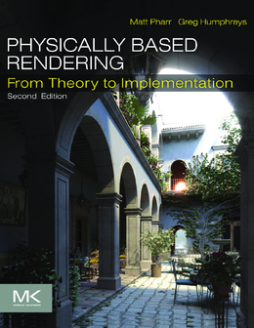
Additional Information
Book Details
Abstract
Physically Based Rendering, Second Edition, describes both the mathematical theory behind a modern photorealistic rendering system as well as its practical implementation.
A method known as literate programming combines human-readable documentation and source code into a single reference that is specifically designed to aid comprehension. The result is a stunning achievement in graphics education. Through the ideas and software in this book, you will learn to design and employ a full-featured rendering system for creating stunning imagery.
This new edition greatly refines its best-selling predecessor by streamlining all obsolete code as well as adding sections on parallel rendering and system design; animating transformations; multispectral rendering; realistic lens systems; blue noise and adaptive sampling patterns and reconstruction; measured BRDFs; and instant global illumination, as well as subsurface and multiple-scattering integrators.
These updates reflect the current state-of-the-art technology, and along with the lucid pairing of text and code, ensure the book's leading position as a reference text for those working with images, whether it is for film, video, photography, digital design, visualization, or gaming.
- The book that won its authors a 2014 Academy Award for Scientific and Technical Achievement from the Academy of Motion Picture Arts and Sciences
- New sections on subsurface scattering, Metropolis light transport, precomputed light transport, multispectral rendering, and much more
- Includes a companion site complete with source code for the rendering system described in the book, with support for Windows, OS X, and Linux: visit www.pbrt.org
- Code and text are tightly woven together through a unique indexing feature that lists each function, variable, and method on the page that they are first described
"Physically Based Rendering is a terrific book. It covers all the marvelous math, fascinating physics, practical software engineering, and clever tricks that are necessary to write a state-of-the-art photorealistic renderer. All of these topics are dealt with in a clear and pedagogical manner without omitting the all-important practical details."--Per Christensen Senior Software Developer, RenderMan Products Pixar Animation Studios
"Intended for graduate or advanced undergraduate students in a computer graphics course, this large volume provides a comprehensive examination of complex rendering algorithms and demonstrates, through detailed examination of source code and example projects, the practical development and application of cutting edge image creation and processing software. This second edition is updated to reflect current technologies and contains updated information on relevant recent hardware improvements such as advanced multi-core processors as well as an increased focus on production graphics techniques. The text includes numerous illustrations, code examples, and formulas as well as recommendations for further reading and chapter exercises. Pharr is a principle engineer for Intel and Humphreys is an engineer for NVIDIA and a former professor of computer science at the University of Virginia."--SciTech Book News
"Pharr and Humphreys’ textbook is beautifully typeset, thoroughly indexed, unendingly cross-referenced, extensively illustrated, and printed in full color. Given its unconventional preparation style, this textbook stands out because of its descriptions of the tradeoffs involved in developing a complete working renderer. Although somewhat verbose at times, the discussions of design tradeoffs and performance considerations are an excellent complement to the more traditional coverage of the theory behind photorealistic rendering. C++ idioms sometimes get in the way of more elegant solutions, but their use is always reasonably justified. If you are just looking for a general introduction to image synthesis and rendering, standard graphics textbooks [2] might fit the bill; however, if you intend to develop your own renderer or try out new ideas, this textbook provides an excellent starting point."--Computing Reviews.com
